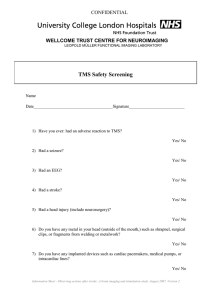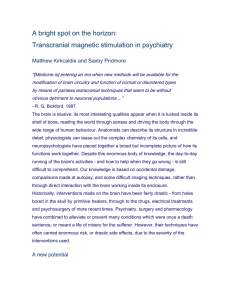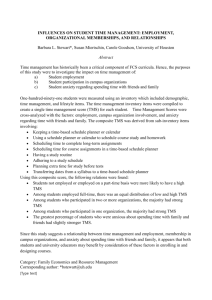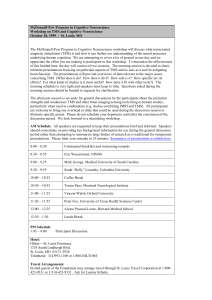How to design neurostimulation studies? Mandana Modirrousta MD PhD FRCPC
advertisement
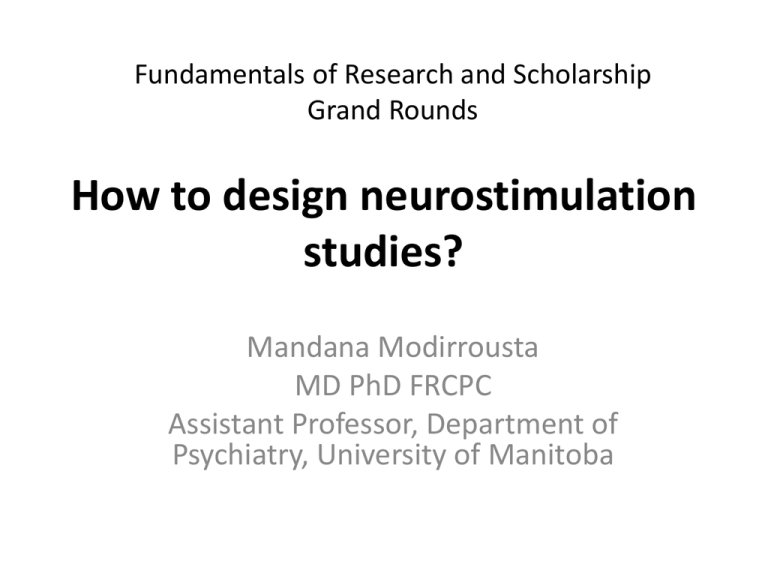
Fundamentals of Research and Scholarship Grand Rounds How to design neurostimulation studies? Mandana Modirrousta MD PhD FRCPC Assistant Professor, Department of Psychiatry, University of Manitoba Brain and Behaviour correlation Other Brain-Behavior Techniques • Lesion Studies – experimental models in animals – Single or few case studies – might be more than a single lesion – lesion may be larger than the brain area under study – Cognitive abilities may be globally impaired – Given brain plasticity, connections might be modified following lesions Other Brain-Behavior Techniques • Cortical Stimulation – Invasive – Limited to the study of patients with brain pathologies requiring neurosurgical interventions – Stressful situation in the OR and medications might condition subject’s performance – Time constraints limit the experimental paradigms – Retesting is not possible Other Brain-Behavior Techniques • Neuroimaging (Brain Mapping) – Non-invasive identification of the brain injury correlated with a given behavior – Association of brain activity with behavior - cannot rule out epiphenomenon – Cannot demonstrate the necessity of given region to function – Neuroimaging techniques are usually only good either temporally or spatially, not both (e.g. Pet & fMRI lack temporal resolution, EEG lacks spatial resolution) TMS in the Study of Brain-Behavior Relations • Study of normal subjects eliminates the potential confounds of additional brain lesions and pathological brain substrates • Acute studies minimize the possibility of plastic reorganization of brain function • Repeated studies in the same subject • Study multiple subjects with the same experimental paradigm • Study the time course of network interactions • When combined with PET or fMRI, can build a picture of not only which areas of brain are active in a task, but also the time at which each one contributes to the task performance. Advantages of TMS: Virtual Patients causal link between brain activity and behaviour Braille Alexia Real lesion Hamilton et al., 2000. Reported case of blind woman who lost ability to read braille following bilateral occipital lesions TMS lesion Cohen et al., 1997. Occipital TMS disrupts braille reading in early blind, but not control subjects Blue = sighted; Red = E blind Advantages of TMS: Chronometry “Chronometry”: timing the contribution of focal brain activity to behavior Role of “visual” cortex in tactile information processing in early blind subjects Hamilton and PascualLeone, 1998 Functional connectivity- relate behaviour to the interaction between elements of a neural network Paus et al. TMS/PET TMS to FEF - correlation between TMS and CBF at i) stimulation site ii) distal regions consistent with known anatomical connectivity of monkey FEF Electromagnetic Induction Introduces disorder into a normally ordered system Summary: What can TMS add to Cognitive Neuroscience ? • “Virtual Patients”: causal link between brain activity and behavior • “Chronometry”: timing the contribution of focal brain activity to behavior • “Functional connectivity”: relate behavior to the interaction between elements of a neural network • Map and modulate neural plasticity To consider while designing an experiment • • • • • • • • • • Sham stimulation On-line vs. off-line paradigm TMS parameters: When and How to stimulate Intensity of stimulation Scalp to Brain Target Distance Frequency of Stimulation Duration of Stimulation Stimulation Parameters and Behavioral Task Where? What are you stimulating? Practical considerations Coil shape The geometry of the coil determines the focality of the magnetic field and of the induced current hence also of the targeted brain area. T Practical Considerations - stimulation depth 70x60 5mm 55x45 40x30 0 15mm 20mm 25mm Cannot stimulate medial or sub-cortical areas Stimulation techniques and possible effects - + Expected effect Single pulse rTMS (low/high fr.) Connected effects Paired pulse + Paradoxical effects Paired pulse Control Conditions Real Different hemisphere Different effect or no effect Sham Different site Or interleave TMS with no TMS trials Safety Seizure induction Hearing loss Heating of the brain Engineering safety Safety Scalp burns from EEG electrodes Effect on cognition Local neck pain and headaches Effect on Mood in normals Safety Follow published safety guidelines for rTMS Maximum safe duration of single rTMS train at 110% MT Frequency (Hz) Max. duration (s) 1 1800+ 5 10 10 5 20 1.6 25 .84 Caution: Guidelines not perfect + minimum inter-train interval e.g. at 20Hz @1.0-1.1 T leave >5s inter train Contraindications •Metallic hardware near coil –Pacemakers –implantable medical pumps –ventriculo-peritoneal shunts (case studies with implanted brain stimulators and abdominal devices have not shown complications) •History of seizures or history of epilepsy in first degree relative •Medicines which reduce seizure threshold Contraindications • • • • • • • Subjects who are pregnant (case studies have not shown complications) History of serious head trauma History of substance abuse Stroke Status after Brain Surgery Other medical/neurologic conditions either associated with epilepsy or in whom a seizure would be particularly hazardous (e.g. increased intracranial pressure) Ethics Guidelines • Informed Consent - disclosure of all significant risks, both those known and those suspected possible • Potential Benefit must outweigh risk • Equal distribution of risk - Particularly vulnerable patient populations should be avoided Major advantages summary Reversible lesions without plasticity changes Repeatable High spatial and temporal resolution Can establish causal link between brain activation and behaviour Can measure cortical plasticity Can modulate cortical plasticity Therapeutic benefits Major limitations summary Only regions on cortical surface can be stimulated Can be unpleasant for subjects Risks to subjects and esp. patients Stringent ethics required (can’t be used by some institutions) Localisation uncertainty Stimulation level uncertainty Question time
